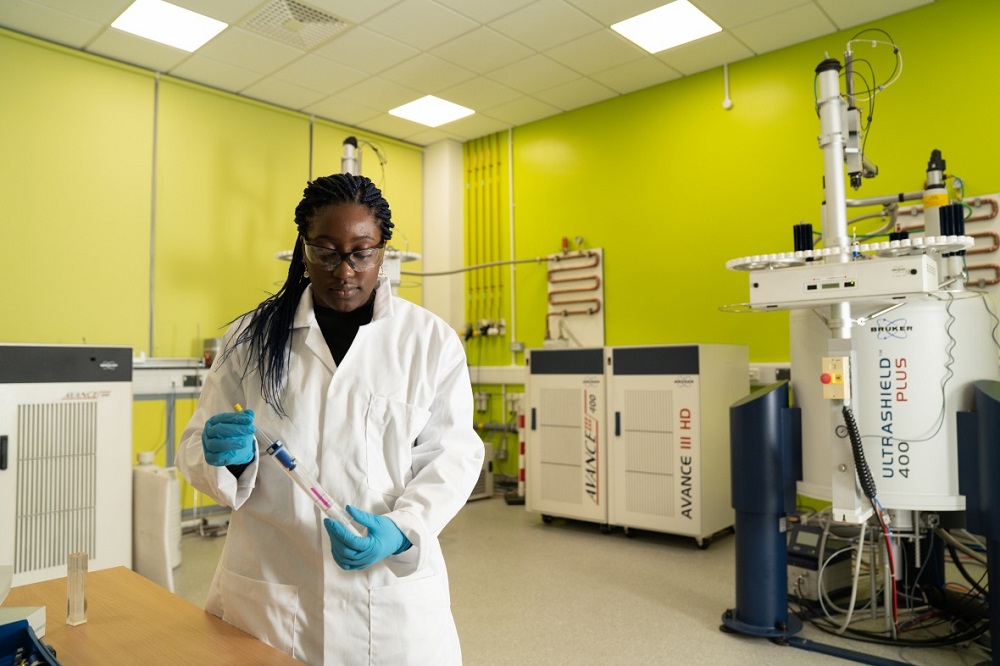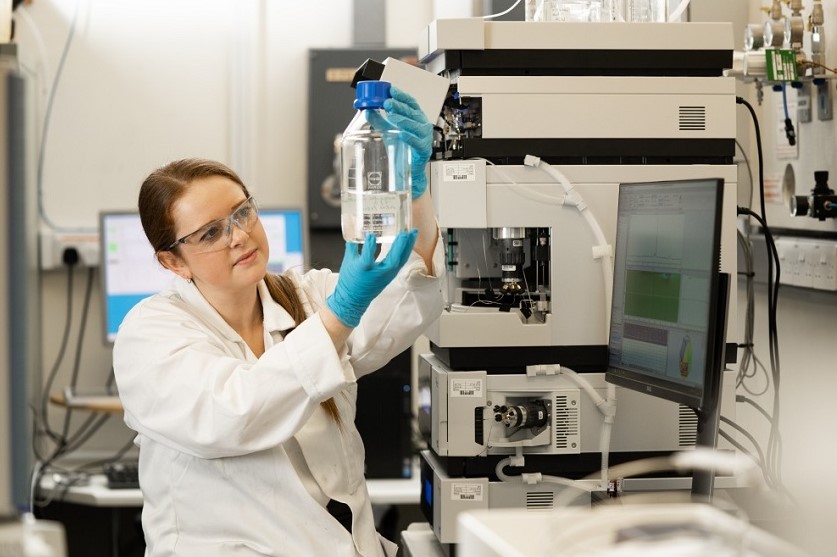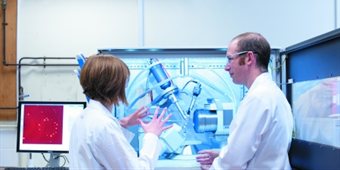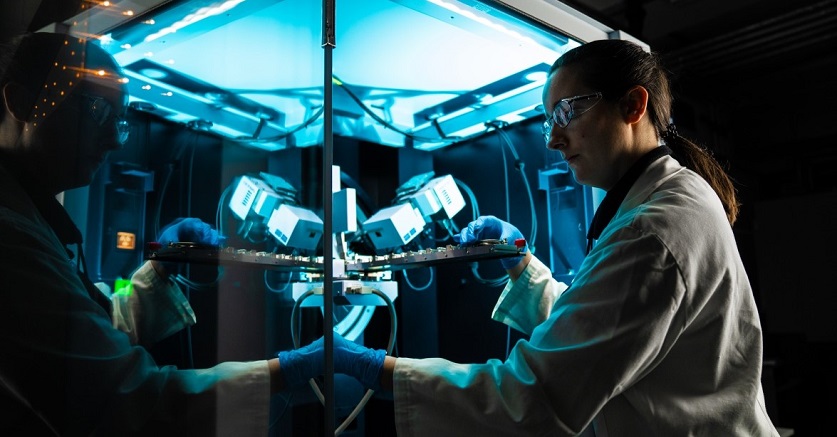Nottingham Analytical and Scientific Services
We can provide cutting edge analytical services and bespoke synthesis solutions at the University of Nottingham through Nottingham Analytical and Scientific Services.
Whether it is your day-to-day analytical needs, such as mass spectrometry, NMR spectroscopy and elemental analysis, or more specialist offerings such as X-ray Photon spectroscopy, circular dichromism, X-ray crystallography we can help.
We have provided assistance to great range of Industries and if you are not sure which analytical technique is best then please get in touch and we will be able to advise you.
Nottingham Analytical Brochure
Consultancy and Collaboration
Client Testimonials
Our Facilties
Nottingham Analytical has access to state-of-the-art analytical equipment including:
- Nuclear MagneticResonance Spectroscopy [400, 500, 800 MHz] (NMR)
- Mass Spectrometry
- Gas Chromatography-Mass Spectrometry (GC-MS)
- Scanning Electron Microscopy (SEM)
- Transmission Electron Microscopy (TEM)
- Inductively Coupled Plasma-Optical Emission Spectroscopy (ICP)
- Dynamic Scanning Calorimetry (DSC)
- Elemental Micro Analysis (CHN)
- X-Ray Photoelectron Spectroscopy (XPS)
- Powder X-Ray Diffraction (PXRD)
- Single Crystal X-Ray Diffraction
- Infrared Spectroscopy
- UV/Vis Spectroscopy
- Light Microscopy
- Confocal Microscopy
- Thermogravimetric Analysis (TGA)
- Circular Dichroism Spectroscopy (CD)
- Gas Sorption Analysis (BET, isotherms)
- Karl Fischer
- Chromatography
- Ion Chromatography (IC)
Contact the Team to find out more
Our Facilties in detail
NMR Spectroscopy
Nuclear Magnetic Resonance (NMR) spectroscopy is a research technique that exploits the magnetic properties of certain atomic nuclei to deliver information on the chemical environment in which the nuclei are found to give detailed information about the structure of the molecules.
Currently there are six NMR instruments in the School of Chemistry with field strengths that vary from 270 to 500 MHz.
We have a number of off-line processing stations for the reprocessing/replotting of data and 600 and 800 MHz NMR instruments.
X-Ray Photoelectron Spectroscopy
X-ray photoelectron spectroscopy (XPS) is a surface-sensitive quantitative spectroscopic technique that measures the elemental composition (at the parts per thousand range), empirical formula, chemical state and electronic state of the elements that exist within a material.
Inductively Coupled Plasma Optical Emission Spectroscopy
Our ICP-OES equipment is capable of delivering quantitative analysis of the elemental composition of a wide range of solutions and formulations up to parts-per-million levels. Ideal for impurity identification and formulation testing.
Electron Paramagnetic Resonance Spectroscopy
Electron paramagnetic resonance (EPR) spectroscopy is a technique for studying materials with unpaired electrons. The basic concepts of EPR are analogous to those of nuclear magnetic resonance (NMR). EPR spectroscopy is particularly useful for studying metal complexes or organic radicals.
Mass Spectrometry
Mass Spectrometry is an analytical tool used for measuring the molecular mass of a sample and has application in chemical, biotechnological and pharmaceutical, geological and clinical sectors.
The School of Chemistry has access to cutting edge mass spectrommetry equipment and a wide range of ionisation techniques including:
- An accurate mass Open Access ToF,
- A MALDI-ToFMS,
- An ultra-high resolution TOF with LC and solid probe inlets
- A triple-quad LC-MS,
- An accurate mass GC-EI-ToF with FD, FI and solid probe inlets
- This allows access to ESI, APCI, MALDI, EI,CI, FD and FI ionisation techniques, with GC-MS and LC-MS for separation and semi-quantification of mixtures.

Raman Spectroscopy
Raman spectroscopy is a technique used to observe vibrational, rotational, and other low-frequency modes in a system. Raman spectroscopy is commonly used in chemistry to provide a fingerprint by which molecules can be uniquely identified.
Single Crystal X-ray Crystallography
Single-crystal X-ray Diffraction is a non-destructive analytical technique which provides detailed information about the internal lattice of crystalline substances, including unit cell dimensions, bond-lengths, bond-angles, and details of site-ordering.
The single crystal diffraction suite consists of 4 high-intensity Rigaku Oxford Diffraction diffractometers. Both Cu and Mo Kα radiation is available, and all instruments are equipped with Oxford Cryosystems Cryostreams. Single crystal data can be collected on extremely small (minimum dimension 0.01mm) and weakly diffracting crystals, and in addition multi-temperature experiments can be performed in to 80-550K range. Services range from data collection only to full structure determination.

Powder X-ray Diffraction Suite
X-ray powder diffraction (XRD) is a rapid analytical technique primarily used for phase identification of a crystalline material and can provide information on unit cell dimensions. This technique can also identify the presence of any crystalline impurities in the solid materials.
The PXRD suite consists of two instruments.
The first is a PANalytical MPD, equipped with a Cu anode X-ray tube, Kα1 monochromator, and modern integrating detector. In addition to standard collections this instrument has multi-temperature capabilities (Anton Paar HTK1200N, 25-1200°C, chamber can be evacuated, under inert gas or air), SAXS capabilities and a variety of standard holders.
The second instrument is a Bruker D8 Advance Powder Diffractometer, equipped with a sealed tube Cu source, capillary spinner, and upgraded Bruker Vantec detector. This system has low temperature (Oxford Cryosystems crystream, 80-500K) and high temperature (Anton Paar HTK16 strip heater, 25-1600°C) attachments.

Circular Dichromism Spectroscopy
Circular Dichromism spectroscopy is used extensively to study chiral molecules of all types and sizes, but it is in the study of large biological molecules where it finds its most important applications.
A primary use is in analysing the secondary structure or conformation of macromolecules, particularly proteins as secondary structure is sensitive to its environment, temperature or pH, circular dichroism can be used to observe how secondary structure changes with environmental conditions or on interaction with other molecules.
Elemental Analysis
The elemental microanalysis service is equipped with an automated elemental analyser, which allows fast determination of the carbon, hydrogen and nitrogen content of a sample to an accuracy of 0.3%.